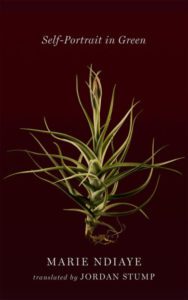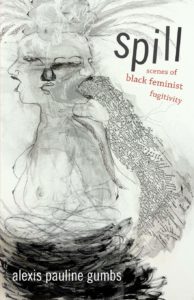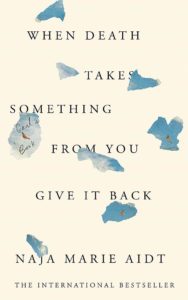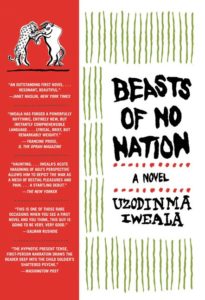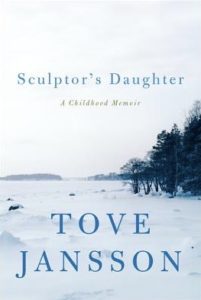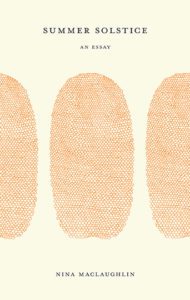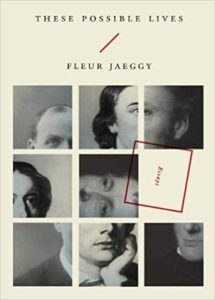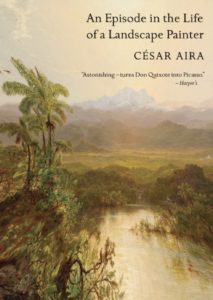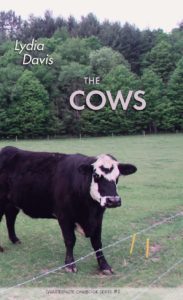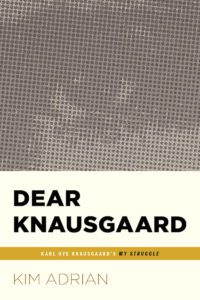I’m not put off by big books. My latest book, Dear Knausgaard, is about my experience of reading Karl Ove Knausgaard’s 3600-page, six-volume opus My Struggle. One of the things I like about big books is how they weave themselves—simply by virtue of taking so long to read—into the very fabric of your life.
The charm of a short book is often gratifying in precisely the opposite way: a short book can take you out of your life. A good short book interrupts the general rhythms/chromatics/energetics of your own existence. The best cast a kind of spell. And like a spell—or a dream—they’re capable of haunting your synapses long after you’ve read the last page.
I also like short books because they are, as a rule, small, which means I can easily carry them around, just as I do my phone. In fact, I try to keep a book next to my phone at all times, so that whenever I reach for that diabolical contraption—whether to refresh my newsfeeds or check my email—I’m forced to make a choice: mindless distraction or a good book. It’s up to you, lady. About half the time, mindless distraction wins. But the other half, Marie NDiaye or Robert Walser or Lydia Davis gets my attention.
Below are some of my favorite quick reads of the past year. Like my favorite long books, most of these works achieve their power by way of voice and imaginative inquiry rather than plot or argument. Some are dark, some light. Some are fiction, some nonfiction (though most carve their own path in regards to genre). A couple are funny. Two are quite sad. All of them cast a spell.
***
Self-Portrait in Green by Marie Ndiaye, translated by Jordan Stump
Emerald, pea, acid, lime. Green, in this slim book, operates as a metaphor for the ambivalence that so often charges the space between women. Not quite a novella and nothing like a memoir (its official genre designation), Self-Portrait in Green is series of character portraits that describes the narrator’s relationships to four dangerous, alluring, yet curiously impotent women. NDiaye’s subtly hallucinogenic prose creates a kind of glittering, low-volume nightmare in which it’s impossible to name or put your finger on any one thing with certainty. Women morph into shadows, shadows become a river, and the river seems to point to the still-living ghost of an anorexic father. It’s all very sinuous and hard to keep track of, like a verdant, choking vine.
The Walk by Robert Walser, translated by Christopher Middleton with Susan Bernofsky
Writing as a form of walking. Walking as a progression through an imagined landscape. Every step in Walser’s The Walk is a word and every word a step that advances this ramble that leads everywhere and nowhere—both, at once! Interludes abound as Walser’s narrator wanders into a milliner’s shop, a bakery, a bank, flirts with a pretty girl, argues with a bookseller, and has lunch with a certain Frau Aebi (who threatens, sweetly, to stuff him until his “back teeth are floating”). By turns charming and inane, The Walk manages to be both wordy and spare, both absurd and mysteriously significant. How does Walser do it? I have no idea. It’s a very strange magic trick, this pensively antic, endearingly manic koan.
Spill: Scenes of Black Feminist Fugitivity by Alexis Pauline Gumbs
This book is alive. The more I read it, the more gingerly I found myself handling its pages, despite the strength and determination of the women depicted within. Spill is composed of a hundred and twenty-three one-page portraits of vividly particular women. Bread, blood, salt, and sugar, bruises, babies, whiskey, and flexed—always flexed, always ready—muscles, illuminate and animate the theme of fugitivity. Gumbs’s women run from history, sexism, racism, and rape. The scenes read as half song, half sermon (though intimately pitched), and taken as a whole create a richly textured chorus through which an exhilarating and deeply intelligent life force surges.
When Death Takes Something from You Give It Back: Carl’s Book by Naja Marie Aidt, translated by Denise Newman
I’ve never read such an unflinching account of grief as When Death Takes Something from You Give It Back, which I think is another way of saying I’ve never read such an open, soul-bare account of love. Aidt’s memoir, about the death of her twenty-five-year-old son, Carl, is a hybrid arrangement of memories, poetry fragments, conjectures, quotes, and conversations with her son’s ghost. Slowly, in reluctant but compulsively elaborated iterations, Aidt reveals the story of Carl’s accidental suicide while on a high gone terribly wrong. The enormity and purity of her grief—and her love—emerges in bits and pieces in this painful collage of sense-making.
Beasts of No Nation by Uzodinma Iweala
Another short book in the “certain to gut you” category, Beasts of No Nation tells the story of Agu, a child swept up in a brutal civil war in an unnamed West African nation. Effectively orphaned, Agu gets picked up by a rebel contingent and soon becomes the special pet of his troop leader, a charismatic giant of a man known only as Commandant, who requires the boy both to rape and to be raped, to pillage, torture, and kill the “enemy” (never an entirely clear entity in the boy’s mind). It would be hard to overstate the depth of the darkness and depravity depicted in Beasts of No Nation, and yet through Agu, who narrates the story in a kind of staccato pidgin English, Iweala manages to shine the pure light of a child’s innocence on even the ugliest of events.
Sculptor’s Daughter by Tove Jansson, translated by Kingsley Hart
Tove Jansson’s Sculptor’s Daughter is a memoir about a very different kind of childhood—one blessed by peace and good parents. There’s a lovely home, ample food, freedom, and time to play. If you’re a fan of Jansson’s fantastic Moomintroll books, you’ll certainly appreciate this collection of her childhood memories, which center around her Bohemian parents, both artists, and their rambling, ramshackle house through which visitors, friends, small animals, and lost eccentrics wander at will. Jansson relates her memories through the eyes of her child self, and in this way captures the seriousness of imagination. For young Tove, snow and black tulle skirts and melting icebergs are all capable of being formidable foes or great friends. It just depends on the slant of the light, or what one ate for breakfast.
Summer Solstice: An Essay by Nina MacLaughlin
Summer as the shadow of winter, the source of sex, the layer of sweet fat skimmed off the top of time’s unyielding passage. Summer as the smell of campfire smoke, the morbid tincture of fruit flies martyred in red wine, the “buttery spread of stars in the air,” the juice of a peach tickling your chin. Summer as—did I mention this already?—sex. And sweat. And the promise of unending youth, and the dissolution of self in the depths of a pond’s murky waters. Summer is all these things and hundreds more in MacLaughlin’s four-part lyric essay, which ultimately renders the season a kind of wildly faceted mirror for both life and death, procreation and decay. And yet the fun stuff, MacLaughlin reminds us on every page, lies between such extremes. And it’s the fun stuff—think hot dogs and hickeys—that make life so “nice to live.”
These Possible Lives by Fleur Jaeggy, translated by Minna Zallman Proctor
Jaeggy’s prose shimmers with idiosyncrasy, yet at the same time feels incredibly natural, almost inevitable. These Possible Lives is comprised of three very brief biographical portraits of three literary luminaries: Thomas De Quincey, John Keats, and Marcel Schwob (perhaps a special case: not quite a luminary, but a serious writer’s writer, like Jaeggy herself). Miracles of concision, Jaeggy’s sketches remind me of the paintings of the sixteenth-century portraitist Jean Clouet. They have a similar elegance, clarity of expression, and simplicity—without ever being simple. Like Clouet’s jewel-like paintings, these sketches are, each one, luminous, delicate, and eccentric in their very precision, and in this way manage to bring to light not only specific historical moments, but whole personalities, sculpted (and ultimately crushed) by character, habit, and fate.
An Episode in the Life of a Landscape Painter by Cesar Aira, translated by Chris Andrews
A kaleidoscopically expansive exploration of the ways in which art, history, and reality intersect, An Episode in the Life of a Landscape Painter is a fictionalized biography of Johan Moritz Rugendas, master of the eighteenth-century practice of “physiognomic painting,” which strove to capture the endlessly reproducible patterns of nature. On a trip to the wilds of Argentina, Rugendas suffers a freak riding accident that essentially rips off his face, and so we have here an irony: the personal physiognomy of this physiognomic painter is obliterated, and the correspondence between his inner life and the outer expression of that life is destroyed. This development manages to seep—partly by way of morphine (which Rugendas takes for pain), and partly by way of a mysterious process of osmosis—into his art, which is increasingly infiltrated by surreal hints of the irreproducible.
The Cows by Lydia Davis
The Cows rocks the prose house with everything it isn’t: there’s nary a hint of a plot, not a semblance of argument, no characters to speak of, not a wisp of dialogue, and the whole thing unfolds in a style so simple and straightforward as to be essentially nonexistent. Which leaves what, exactly? Just Davis’s favorite duo: subject and object. The subject in this case is the same as it is in all of her work, which is to say her own observant, searching mind. The target of Davis’s contemplation is the small herd of cows that roam a field near her house. Strangely, Davis and the cows are enough. They are plenty. Because the act of thinking, when Davis goes at it, is always interesting—infused with an elegant objectivity, a slightly neurotic curiosity, and an existentially droll esthetic.
And to close out this wonderful list, we just had to include Kim’s new book, Dear Knausgaard: Karl Ove Knausgaard’s MY STRUGGLE, forthcoming on August 25 from Fiction Advocate! – Ed.
Dear Knausgaard: Karl Ove Knausgaard’s MY STRUGGLE by Kim Adrian
In a series of warm and often funny letters, essayist and memoirist Kim Adrian delivers a compelling feminist critique of the six-volume autobiographical novel My Struggle, by Norwegian writer Karl Ove Knausgaard. Adrian’s book of letters begins as a witty and entertaining response to a seminal work and transforms into a fierce and powerful interrogation of the darker social and cultural forces informing Knausgaard’s project. Through an examination of the curious operations of intimacy demanded on both sides of the page by all great literature, Dear Knausgaard ultimately provides a heartfelt celebration of the act of reading itself.

